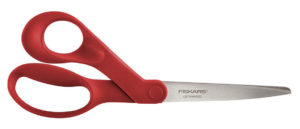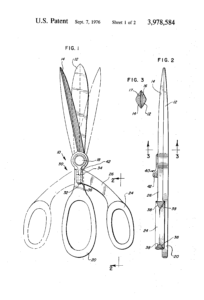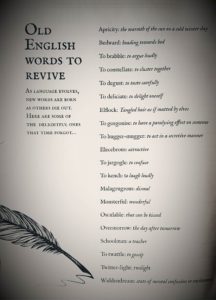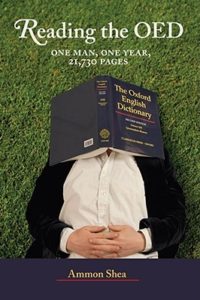 I recently requested, and acquired, a pair of left-handed scissors for my office. I was pleased to discover, with a quick search, that it was possible to order explicitly left-handed titanium-bonded scissors that exactly matched the scissors in the copy room cabinets. In fact, as I discovered when they arrived, they say “LEFTY” only on the package and not on the scissors, which say merely “Westcott titanium” and are therefore indistinguishable from the right-handed scissors except for the orientation of the blades. I held them up together to check. And then, alas, I had to check the other right-handed scissors in the cabinet to make sure I took my own set back to my office.
I recently requested, and acquired, a pair of left-handed scissors for my office. I was pleased to discover, with a quick search, that it was possible to order explicitly left-handed titanium-bonded scissors that exactly matched the scissors in the copy room cabinets. In fact, as I discovered when they arrived, they say “LEFTY” only on the package and not on the scissors, which say merely “Westcott titanium” and are therefore indistinguishable from the right-handed scissors except for the orientation of the blades. I held them up together to check. And then, alas, I had to check the other right-handed scissors in the cabinet to make sure I took my own set back to my office.
So here’s a thing about myself that I find frustrating: in spite (or possibly because) of the fact that I can read upside down and backwards,* I have a really hard time holding onto pattern changes in three dimensions. I turn something over, and, poof, everything I know about it vanishes. I’m not good with Rubik’s cube (I can get one side, but then I lose track), not good with folding washcloths so they face the same way when they’re done (actually, I can do this now, if I concentrate), and not good at remembering how the blades of scissors should be oriented to each other. I say things like, “okay, so the bottom blade is on the left,” and then I pick up a different pair of scissors and suddenly I’m not sure whether I’m holding them the same way, or which blade is now on the bottom, or whether I really was talking about the handle. I think it’s because I don’t have words for the transformation. Which means I can’t trust myself to look at scissors and know whether they’re for left- or right-handers. I have to trust other people, or the marketing.
 And why shouldn’t I trust the marketing? I’m so glad you asked. I don’t trust the marketing because Things Have Changed in scissor handedness world. For example, I’ve asked whether there are left-handed scissors available for my kid in a craft situation, and I’ve been told that all the scissors should work for both hands. And when I dismiss this as ridiculous, and go off to find scissors (for kids or grownups) in an office supply store, I find packages that actually, explicitly say “left or right handed”.** I look at the scissors. They look like scissors. They are oriented only one way. There is no possibility that they can work the same way for right-handed and left-handed people. This is what we call creative marketing – or, possibly, lying.
And why shouldn’t I trust the marketing? I’m so glad you asked. I don’t trust the marketing because Things Have Changed in scissor handedness world. For example, I’ve asked whether there are left-handed scissors available for my kid in a craft situation, and I’ve been told that all the scissors should work for both hands. And when I dismiss this as ridiculous, and go off to find scissors (for kids or grownups) in an office supply store, I find packages that actually, explicitly say “left or right handed”.** I look at the scissors. They look like scissors. They are oriented only one way. There is no possibility that they can work the same way for right-handed and left-handed people. This is what we call creative marketing – or, possibly, lying.
And no one would have made these claims when I was a kid. Either they’d have the little scissors with the green covered handles and “LEFTY” carved into the blade, or they’d apologise and say I’d have to use the right-handed ones. None of this “don’t worry; they’re the same” nonsense.
Just to be clear, the reason it’s important to have left-handed scissors for left hands is that the angle of force is reversed when you switch hands. It’s possible – and often necessary – for a lefty to use right-handed scissors (or vice-versa; if you haven’t tried it, you might find it educational, particularly with older scissors), but instead of the natural movement of your thumb forcing the blades against each other, the natural movement forces the blades away from each other. So if there is any give in the joint at all, you have to work to counter that force – resulting in awkward cutting and generally a slight gouge in your thumb where you have to pull back against the metal. At the time, I believed this to be generally known … and yet, over time, this knowledge seems to have dissipated.
I have a hypothesis as to why this is, and it is twofold:
1) Right-handed scissors (and scissors in general) are now better made. Better joints, smoother motion, less awkward angling, fewer gouges. No problem. At least…no obvious problem. And this is certainly preferable to the earlier models. It’s just not accurate to claim, in one’s marketing, that these scissors are made for both hands.
2) The gouges were, of course, much clearer when scissors were made just with metal. And then there were plastic-coated handles, and then thicker plastic handles. At some point, there came a craze for scissors with big, swooping, molded plastic handles that were ergonomically designed and only faced one way. So then OF COURSE they could only be used for one hand. And I have several pairs of lovely left-handed scissors at home that I have loved and cherished and would never offer to my right-handed spouse except in times of dire need.

But then, according to my hypothesis, people shifted their understanding to fit the new reality and came to believe that the problem with right-handed scissors was that left-handed people couldn’t get their hands into them properly. Take away the ergonomically exclusive handles and, voila! They can be used with both hands.
(Facepalm here, with either hand, or, indeed, both.)
However, there is no way to make regular scissors symmetrical (without a special patent; see below), which means there is no way they can be used equally with both hands. If the companies want to go ahead and make them all left-handed and then claim that they are “for left or right hand,” then I might be on board with it. While I have not been able to tell by looking so far (for reasons mentioned above), I think it is a pretty fair guess that no, this is not what they’re doing. And for this reason, I wrote the following in my request for the scissors, along with the link I had found:
“IMPORTANT: Whatever brand it is, it actually has to have the blades reversed to be for lefties. Anything that says it works “for both hands” is basically saying “we’ve made these right-handed scissors that left-handed people can use if they don’t mind using right-handed scissors.” So, not that. (-:”
However, about the title of this post: In my most recent search for the “either hand” marked scissors, I discovered that there is in fact a patent from the 1970s for ambimanual scissors.*** These are scissors that can actually be used in a symmetrical way by either hand. Here is the abstract (emphasis mine):

sketch from US Patent US 3978584 A
“Scissors which may be used with equal ease and efficiency by either a left-handed or right-handed person. The scissors include two generally flat rigid, blade portions which are each sharpened on both edges to provide two sets of cutting edges. The blade portions are pivotally connected to one another and each includes a handle portion on one end. One of the handle portions is adapted to fit the thumb of the user while the other handle portion is larger to permit engagement of two or more fingers of the same hand in the normal fashion of scissors use. The thumb handle is pivotally mounted to its respective blade portion to permit pivotal movement from one selected position at one side of the finger handle as used during right-handed operation to a second selected position at the opposite side of the finger handle for use during left-handed operation. A detent or lock is provided to secure and hold the thumb handle in either of the selected positions.”
Clearly one has to be careful, what with the double edges. But I think it’s pretty cool.
By the way, I have also found that Wikipedia has a nice, brief description of the symmetry issue (including reference to the aforementioned patent). I actually had forgotten the bit about the visibility of the cutting edge!
—–
* The reading upside-down and backwards thing has caused other problems, as in my early trips to England, where people drive on the other side of the road, and where (since, despite believing that we all have learned to “look both ways” before crossing a street, we actually tend to look only one way at a time) crossing the street can be treacherous. Many London streets kindly warn foreigners where the traffic will be by having very clear “look left” or “look right” signs, with arrows, painted into the road as you step off the curb (sorry, kerb). And this is lovely, and entirely useful. The problem for me comes when there’s a median in the road. For then they have a new sign, just after the median, telling you to look the other way. Which is also fine, except if you happen to read upside-down automatically and therefore don’t particularly distinguish between the sign after the median, which is for you, and the one right before it, which is for people coming the other way. Oops… Fortunately, I never actually got hurt (or picked up as a spy) due to this problem.
** I was pretty disappointed to look back in my notes from such a trip back in August and to learn that the offending scissors were *also* made by Westcott.
*** They are in fact called Ambidextrous scissors, but I prefer to use the alternative I was offered in adolescence by my friend Anna Licameli, summer program roommate, whom I credit with leading my second foray into identity politics. (The first, much earlier, was my beleaguered dad saying, “Why do you keep saying the tooth fairy is female?”) Within our first hour of meeting, she demanded to know why I was wearing my watch on my left arm if I was left-handed, and soon afterward pointed out to me that “ambidextrous” glossed as “right-handed on both sides” and should therefore be avoided.



 I recently requested, and acquired, a pair of left-handed scissors for my office. I was pleased to discover, with a quick search, that it was possible to order explicitly left-handed titanium-bonded scissors that exactly matched the scissors in the copy room cabinets. In fact, as I discovered when they arrived, they say “LEFTY” only on the package and not on the scissors, which say merely “Westcott titanium” and are therefore indistinguishable from the right-handed scissors except for the orientation of the blades. I held them up together to check. And then, alas, I had to check the other right-handed scissors in the cabinet to make sure I took my own set back to my office.
I recently requested, and acquired, a pair of left-handed scissors for my office. I was pleased to discover, with a quick search, that it was possible to order explicitly left-handed titanium-bonded scissors that exactly matched the scissors in the copy room cabinets. In fact, as I discovered when they arrived, they say “LEFTY” only on the package and not on the scissors, which say merely “Westcott titanium” and are therefore indistinguishable from the right-handed scissors except for the orientation of the blades. I held them up together to check. And then, alas, I had to check the other right-handed scissors in the cabinet to make sure I took my own set back to my office. And why shouldn’t I trust the marketing? I’m so glad you asked. I don’t trust the marketing because Things Have Changed in scissor handedness world. For example, I’ve asked whether there are left-handed scissors available for my kid in a craft situation, and I’ve been told that all the scissors should work for both hands. And when I dismiss this as ridiculous, and go off to find scissors (for kids or grownups) in an office supply store, I find packages that actually, explicitly say “left or right handed”.
And why shouldn’t I trust the marketing? I’m so glad you asked. I don’t trust the marketing because Things Have Changed in scissor handedness world. For example, I’ve asked whether there are left-handed scissors available for my kid in a craft situation, and I’ve been told that all the scissors should work for both hands. And when I dismiss this as ridiculous, and go off to find scissors (for kids or grownups) in an office supply store, I find packages that actually, explicitly say “left or right handed”.

 A couple of months ago, a friend posted a list** of “Old English Words to Revive,” and I was charmed to see that the first word on the list was “apricity”.
A couple of months ago, a friend posted a list** of “Old English Words to Revive,” and I was charmed to see that the first word on the list was “apricity”.
